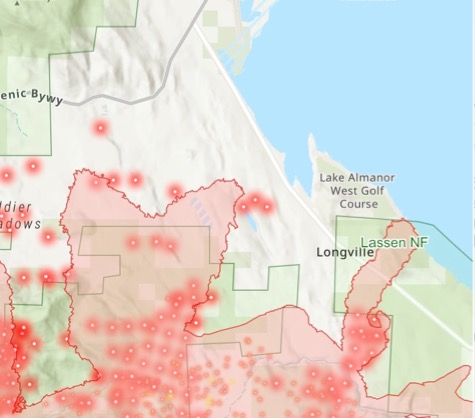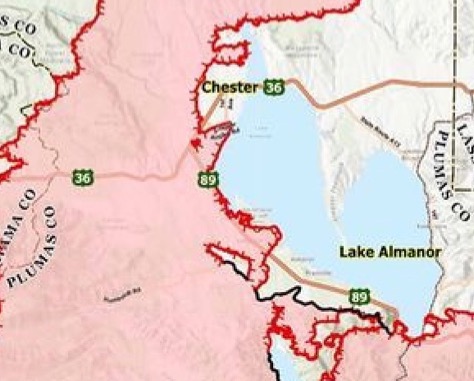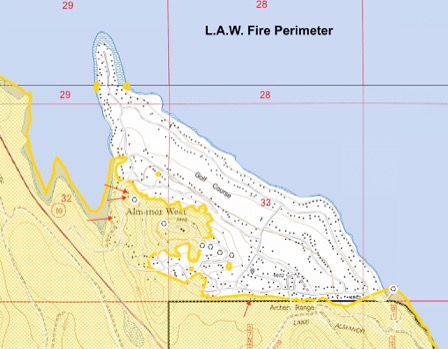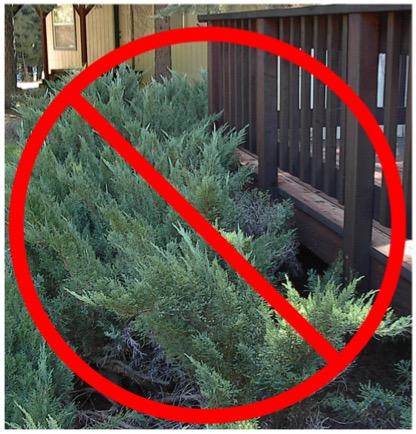The 2021 Dixie Fire
Years of Firewise preparations were put to the test during 2021 when Lake Almanor West was attacked by the Dixie Fire. This massive blaze assaulted the community twice, first with a narrow flame front that passed through adjoining Lassen National Forest lands on the evening of August 3, and then with a broad front that came from the west across Collins timberlands and Hwy 89 on the afternoon of August 5. The latter case was an intense, wind-driven crown fire. Firefighters were able to stop the first onslaught at the southern boundary of the development, but the second raging fire did enter Lake Almanor West and caused the loss of several structures. Nevertheless, the large force of firefighters saved most homes in the burn zone and prevented the fire from spreading further. The map below illustrates the fire perimeter after the narrow incursion on August 3, when fire reached the Lake Almanor West boat launch and directly threatened numerous Osprey Loop homes.

The second map shows the general impact of the larger August 5 assault, when fire entered Lake Almanor West and fully engulfed the western and southern forested areas. On that day the fire also proceeded north to flank Chester,

This final map provides more detail of the burn zone within Lake Almanor West. The yellow area is the burn zone while the little red arrows indicate where structures were destroyed. Amazingly, most structures inside the burn zone were saved by firefighters.

The Dixie Fire continued northward after impacting Lake Almanor West, ultimately reaching a size of 963,000 acres (1505 square miles), the largest single fire in California history. It had started on July 13, 2021, in the Feather River Canyon and was not fully contained until October 26.
Dixie Fire Briefing
A more comprehensive look at the local impact of the Dixie Fire is found in an annotated briefing found at this LINK.
Post-Fire Landscaping
One of the factors that worked in our favor during the Dixie Fire was the cleaned up condition of most of the development. You have heard time and again that the condition of our yards is a very important factor in determining whether our residences will survive a wildland fire. State law, implemented by CalFire, requires that we create "defensible space" around our homes, with the greatest emphasis nearest our structures. The first several feet around our homes need to be free of combustible materials, but thereafter we have some choices to make regarding vegetation. We often combine natural vegetation with landscape plantings in our yards, and this is where our choices of what and where to plant become quite important.
General guidelines regarding vegetation spacing and density are found on the "Good Practices" page of tis website. Here, however, we will discuss some of the basic elements that affect our choices in landscaping practices. While there are no totally fireproof plantings, there are things to avoid and things to favor when selecting landscaping vegetation. Just remember that ALL vegetation will burn under the right conditions, and all vegetation needs to be viewed as potential fuel for a fire.

Things to Avoid
• It is vital that we avoid shrubs right up next to structures, most especially if those shrubs are easy to ignite such as the above example of junipers next to a deck.
• Avoid continuous fuel beds (especially shrubs and tall grasses) by separating your plantings.
• Except as isolated specimens, avoid vegetation that is prone to shedding dry material, accumulating dead material underneath a green surface layer, or having a high resin or oil content. Examples to avoid include juniper (above), manzanita, Italian cypress, feather grasses, etc.
• Avoid combustible material (such as bark chips) near structures.
• Avoid planting shrubs under trees, where the shrub may act as a fuel ladder into tree crowns.
Things to Favor:
• Use noncombustible mulch (e.g., gravel or rock) right next to structures
• Use gravel, concrete or paver pathways to help separate vegetation and break up fuel beds in the yard.
• Use low-growing vegetation (including lawn) in the defensible space zone nearest structures. Taller vegetation can be planted further away.
• Favor hardy, slow-growing plants that are reasonably draught tolerant.
• Favor deciduous tree varieties.


